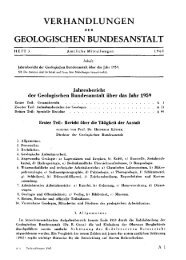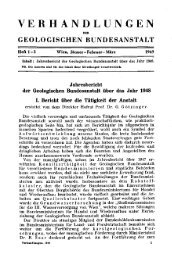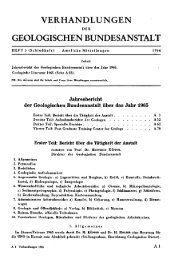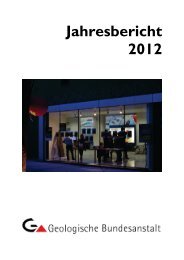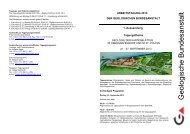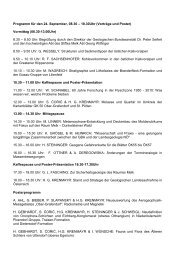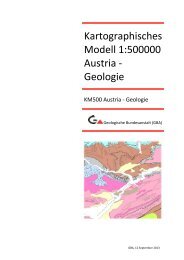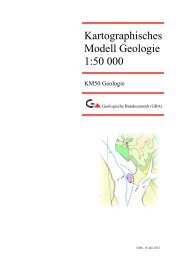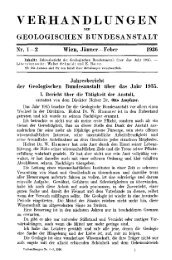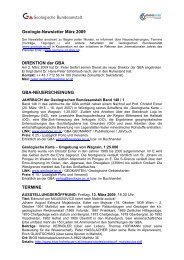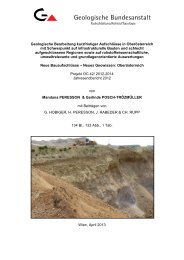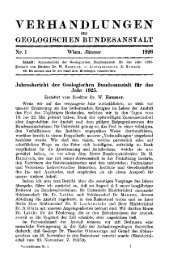Field Trip B TRIASSIC CONODONT LOCALITIES OF THE ...
Field Trip B TRIASSIC CONODONT LOCALITIES OF THE ...
Field Trip B TRIASSIC CONODONT LOCALITIES OF THE ...
Create successful ePaper yourself
Turn your PDF publications into a flip-book with our unique Google optimized e-Paper software.
The Ecxursion<br />
DAY 1<br />
Feuerkogel near Bad Aussee, Middle and Upper Triassic Hallstatt Limestone<br />
(Stratotype of the Tuvalian Substage; Anisian to Lower Norian conodonts).<br />
Access of the locality from Hallstatt is along the river Traun via Bad Aussee to Mitterndorf. Leaving<br />
Hallstatt on the roadside mainly Dachstein Lst. is exposed representing a cyclic lagoonal type sediment<br />
of the so-called „Loferer type" (A. G. FISCHER 1964). Upon Bad Aussee the valley opens and forms<br />
a wide depression filled with fluviatil Quarternary deposits. From Mitterndorf the route runs through<br />
the Salza valley to Kochalm and further westward on a forrest road to Teltschenalm. Starting at an altitude<br />
of approx. 1350 m we will arrive at Feuerkogel (1625 m) after one hour walk. On the official<br />
topographic map (sheet 97, Mitterndorf) Feuerkogel is indicated as an unnamed elevation on the east<br />
side of Mount Rötheistein.<br />
The mountain Feuerkogel (fig. 9) is one of the numerous tectonic blocks developed in Hallstatt fades<br />
which in the surroundings of Mitterndorf tectonically overlay the Dachstein nappe (cf. TOLL-<br />
MANN 1960). Feuerkogel consists of some 50 m of moderately north dipping Hallstatt Lst.<br />
The complete section is exposed at the southern side beginning in the Middle Anisian with Reifling<br />
Lst. (Kockeli-Zone). They are followed by dark marls presumably of Upper Anisian age, forming a<br />
small depression. On the ascent to the peak the following members of Hallstatt Lst. will be passed:<br />
1) Lower Ladinian „Grauvioletter Bankkalk" (grey violet bedded 1st.), poor in conodonts;<br />
2) Ladinian „Roter Knollenflaserkalk" (red nodular flaser-lst.), poor in conodonts;<br />
3) Upper Ladinian to lowermost Norian „Roter Bankkalk" (red bedded 1st.) with abundant conodonts<br />
but in part condensed faunas;<br />
4) Lower Norian „Massiger Hellkalk" (massive light 1st.) rich in conodonts, forming the peak.<br />
Compared with earlier reports (KRYSTYN 1973) the age of the „Roter Knollenflaserkalk" and of<br />
„Roter Bankkalk" has been slightly changed depending on new conodont evidence. The classic ammonite<br />
localities described at Feuerkogel occur in the „Roter Bankkalk" and in part also in the overlying<br />
„Hellkalk". Their maximum age range from the Upper Ladinian to the Lower Norian; faunas from two<br />
fissures even indicate Middle and Upper Norian. During the excursion three fossil localities (quarries)<br />
will be visited (Fl, F4, F5). Two others, still existing, are due to their sedimentary structures too complicated<br />
and therefore not suited for detailed biostratigraphic studies.<br />
„The Feuerkogel is probably one of the most famous cephalopod collecting sites in the world. The<br />
rocks exposed near its peak have yielded thousands of specimens of ammonoids, nautiloids, pelecypods<br />
and other invertebrate fossils. During the last century a rather sizable industry was developed through<br />
wich an extraordinary number of cephalopods were quarried out of these rocks and sold to museums,<br />
collectors, and tourists. MOJSISOVICS in the last half of the last century described 444 cephalopod<br />
species from these strata" (MOSHER 1968, p. 903); DIENER added some 20 more.<br />
Conodont research<br />
The Feuerkogel represents one of the most important Triassic conodont localities of the world, both<br />
for stratigraphic reasons and concerning abundance of conodonts. The locality is closely related to the<br />
study of Triassic conodonts. It is the type locality of three diagnostic platform conodonts of the Triassic,<br />
namely, Gladigondolella tethydis (HUCKRIEDE 1958, p. 157), Gondolella navicula (HUCKRIE-<br />
DE 1958, p. 147), and Gondolella excelsa (MOSHER 1968, p. 158). Furthermore, a certain number of<br />
Triassic ramiform elements were first described at Feuerkogel.<br />
Following HUCKRIEDE 1958, MOSHER 1968, p. 915 carried out an excellent study of the conodont<br />
fauna. He also drew attention to the discrepancies between the ranges of several index species<br />
(quarry Fl) and concluded stratigraphic condensation. Some years later KRYSTYN 1972, 1973 presented<br />
a detailed stratigraphic synthesis of the Feuerkogel and its main fossil sites including a correlation<br />
of ammonoid and conodont biostratigraphy. KRYSTYN's results were questioned and critizised<br />
in a quite unusual way by KOZUR 1973 who — unfortunately — never was able to visit parts of the section<br />
at Feuerkogel. His samples were collected by another person and sent to him. Though KOZUR<br />
had no real stratigraphic control of his samples he tentatively assigned them to certain beds of the<br />
section. This, in fact, may explain his misinterpretations.<br />
So far, Feuerkogel has been the only place in the Tethys realm where it is possible to correlate precisely<br />
the ammonite and conodont chronologies in the Upper Karnian and Lower Norian. Beside this<br />
81



